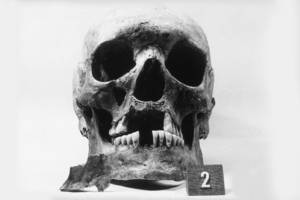Chewing through the fossil record
Interview with
The presence of tools are often used to show a hominin site but the clues are  even clearer if you find human or human relative remains. But how much can a piece of skeleton really tell you? Connie Orbach went to meet UCL's María Martinón-Torres who has been getting her teeth into the subject...
even clearer if you find human or human relative remains. But how much can a piece of skeleton really tell you? Connie Orbach went to meet UCL's María Martinón-Torres who has been getting her teeth into the subject...
Maria - We really look at the skeletons and the skeletons will show very important differences between species that we can really try to investigate and to understand what the anatomy was well-suited for. Which type of behaviour, locomotion they were having or changes throughout human evolution, so we were more robust now we're more gracile.
But, particularly, in this aspect, it is very interesting to look at the dentition because teeth are really, really very useful apart from being the skeletal part that usually gets more well-preserved in the fossil record. But the interesting part about teeth is the size but mostly the shape of the teeth are genetically designed. So, in a way, they are really reflecting in a very conservative manner some of type of genetic inheritance. So all those little cusps, grooves we see, those little tubercles and things that we are looking at, each of those traits have a strong genetic component. So, you know, we can't always look at the genes to really see the genetics of the species because the DNA is not always preserved. But by comparing this pattern of grooves, cusps and the shape of the teeth we can really try to infer the type of kinship there was with extinct species.
Connie - And have you got any examples that you can show me
Maria - Yes, sure.
Connie - Oh fantastic... Oh specimen store - Oh my gosh. There's so many skulls.
Maria - Yes. This is a chimpanzee, a female chimpanzee and this is a human. This is a Paranthropus or a robust Australopithecus and this is a gracile Australopithecus like the group that Lucy belonged to.
Connie - Okay. What can we see from the teeth here?
Maria - I would say that the big difference is that homosapiens became very boring, very simple. We have very simplified teeth, very small in general, in absolute and relative terms we have small teeth, but it's not only about size. If you look at the morphology you have quite simple occlusal faces, the part you use for chewing. You don't really see many features, many grooves - yes, quite simple.
However, the teeth of other species that were more primitive. Here I'm showing you for example a Australopithecus robustus. It's not only about the size which you can really see the difference...
Connie - Yeah.
Maria - ... in the size of the teeth. But also look at these they are much more boroc, so you really have many more grooves, accessory cusps. There is really much more complicated occlusals surfaces than those that we have.
Connie - And you can really see why we have so much smaller jaws than monkeys and things because our teeth are so much smaller to fit in in the first place?
Maria - I would say that there is less pressure on our mastication because we really help ourselves with something else than with teeth. With stone tools, with fire and cooking and we rely less on our teeth for survival and in the past it was really an issue. Nowadays we don't need to be the healthiest or the strongest to survive. Instead it is the one who has better connections that survives.
Connie - In fact, some of us don't have teeth.
Maria - Yes indeed, so it no longer means the fittest is the strongest physically. It's about your contacts, your friendships maybe, your influence, or your money so in that sense it really has changed a lot - our relationship with the world and with a group.










Comments
Add a comment